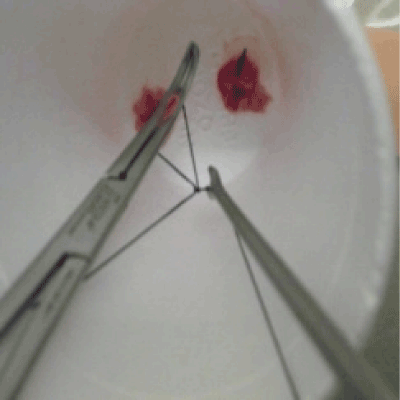The Cardiff Cup: A Model for Tonsillectomy Tie Training
Received: 11-Jul-2011 / Accepted Date: 14-Jul-2011 / Published Date: 23-Jul-2011 DOI: 10.4172/2161-119X.1000102
Abstract
Tonsillectomy is a procedure commonly performed by otolaryngologists. The National Prospective Tonsillectomy Audit [1] reported reduced postoperative haemorrhage rates using cold steel dissection combined with ligation for haemostasis in comparison to hot tonsillectomy techniques. Accordingly, there is growing emphasis on the need for ENT surgical trainees to develop competence in tonsillectomy ties for haemostasis. Tonsillectomy tie technique is an important skill that requires good manual dexterity and one that is difficult to learn under the pressure of a bleeding patient. Furthermore, in the UK, opportunities for junior surgical trainees to undertake tonsillectomy tie training in the operating theatre have been limited by the enforcement of the European Working Time Directive [2]. Thus, there is a growing need for the use of simulation to practise tonsillectomy ties. We present a simple, readily available and economical simulation model for surgical trainees to practise tonsillectomy ties.
Tonsillectomy is a procedure commonly performed by otolaryngologists. The National Prospective Tonsillectomy Audit [1] reported reduced postoperative haemorrhage rates using cold steel dissection combined with ligation for haemostasis in comparison to hot tonsillectomy techniques. Accordingly, there is growing emphasis on the need for ENT surgical trainees to develop competence in tonsillectomy ties for haemostasis.
Tonsillectomy tie technique is an important skill that requires good manual dexterity and one that is difficult to learn under the pressure of a bleeding patient. Furthermore, in the UK, opportunities for junior surgical trainees to undertake tonsillectomy tie training in the operating theatre have been limited by the enforcement of the European Working Time Directive [2]. Thus, there is a growing need for the use of simulation to practise tonsillectomy ties. We present a simple, readily available and economical simulation model for surgical trainees to practise tonsillectomy ties.
Equipment
200 ml foam cup, gauze swab, adhesive tape, red marking pen, tonsillectomy.
Instruments
Curved Negus forceps, Negus knot pusher, curved scissors and silk ties. Using a foam cup to simulate the oral cavity, gauze swabs are passed through two holes made on the lateral aspects of the bottom of the cup. The gauze represents the tonsillar beds on either side. A bleeding vessel is depicted with a red marking pen on the gauze. This is clamped using the Negus curved forceps. The trainee then proceeds to ligating the bleeding vessel in the tonsillar bed with silk ligatures using a Negus knot pusher (Figure 1).
Although more sophisticated tonsillectomy tie models have been proposed, [3,4] this model is very simple, easy to construct from household items and economical. It allows the trainee to become competent at applying ties at depth to the left and right tonsillar fossa using the dominant and non-dominant hand. Moreover, tying at depth in this model closely corresponds to the real anatomical distance to the tonsillar beds [4]. Additionally, any ‘cheese-wiring’ of the lips during tying would be apparent as markings on the upper surface of the cup making the trainee cognisant of avoiding this.
Given its very basic nature, this model does not fully mimic the spatial orientation available during a tonsillectomy. However, it allows the junior trainee to become familiar with tonsillectomy instruments and develop the manual dexterity required to apply ligatures in a controlled environment. We hope that otolaryngology trainees may utilise this model as a simple aid to their training.
References
- Lowe D, van der Meulen J, Cromwell D, et al. (2007) Key messages from the National Prospective Tonsillectomy Audit. Laryngoscope 117: 717-724.
- Hall L, Lee M (2011) Training for tonsillectomy: home-made Negus knot pusher. Clin. Otolaryngol. 36: 99-100.
- Raja MK, Haneefa MA, Chidambaram A (2008) Yorick's skull model for tonsillectomy tie training. Clin. Otolaryngol. 33: 187-188.
- Street I, Beech T, Jennings C (2006) The Birmingham trainer: a simulator for ligating the lower tonsillar pole. Clin. Otolaryngol. 31:79.
Citation: Al-Hussaini A, Addams-Williams J, Tomkinson A (2011) The Cardiff Cup: A Model for Tonsillectomy Tie Training. Otolaryngol 1:102. DOI: 10.4172/2161-119X.1000102
Copyright: © 2011 Al-Hussaini A, et al. This is an open-access article distributed under the terms of the Creative Commons Attribution License, which permits unrestricted use, distribution, and reproduction in any medium, provided the original author and source are credited.
Share This Article
Recommended Journals
Open Access Journals
Article Tools
Article Usage
- Total views: 20400
- [From(publication date): 8-2011 - Apr 05, 2025]
- Breakdown by view type
- HTML page views: 15726
- PDF downloads: 4674

